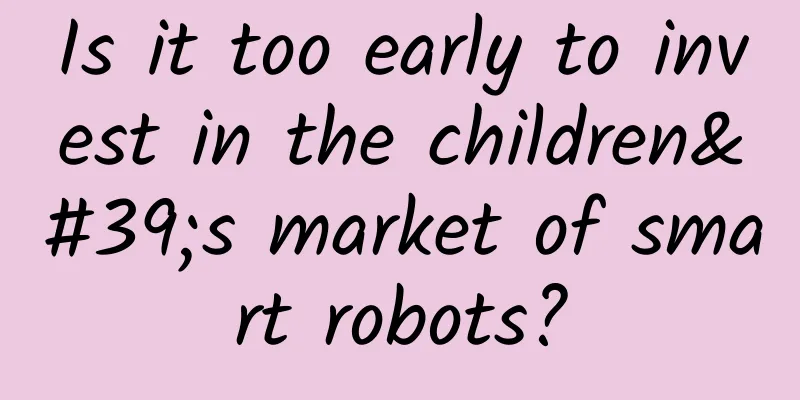Is it too early to invest in the children's market of smart robots?

|
After nearly three years of development, the domestic smart hardware market has begun to take shape. From the user perspective, products have gradually differentiated into the markets for the elderly, infants, women, and children. Looking at the children's market alone, these products also have different functional focuses, such as education, games, or companionship. With the development of artificial intelligence, robots that used to only appear in science fiction movies will appear more and more frequently in people's daily lives. On the one hand, children are more receptive to new things; on the other hand, children's needs are not as complicated as those of adults. So, will the field of robots for the children's market be the next blue ocean for smart hardware? A person in the field of smart hardware investment revealed to us that in the early stage of product design, we can examine the probability of success from three aspects: users, pain points, and technology. Of course, this also applies to robot products for the children's market. user At the user level, the main consideration is whether the product is targeted, as well as the size and purchasing power of the target population. This will directly affect the shipment volume of the subsequent product. According to the results of China's 6th census in 2010, there are more than 220 million children aged 0 to 14 in my country, and the vast majority of this group of people are what we often call the post-00s. Although they do not have purchasing power themselves, their parents are precisely the backbone of today's society, mainly those born in the 1970s and 1980s. In addition to having the necessary spending power, compared with their parents, these parents are often better educated, more willing to accept new things, and pay more attention to investing in their children. This can be seen from the children's education market and toy market, which have continued to expand in the past two years. Therefore, some industry insiders have estimated the smart toy market to be worth hundreds of billions of dollars, which of course includes some robot products. Pain Points The pain point problem is actually the user demand problem. After determining the consumer group, the next problem that smart hardware products have to face is to accurately identify their actual needs. So can smart robots solve the pain points of the consumer market? From the current market perspective, education and companionship are still the two major pain points in the robot children's market. Xiaoyu at Home, which completed a $10 million Series B financing in May this year, is an intelligent robot product that focuses on companionship. According to relevant statistics, there are currently 56% of empty-nest families in China, and nearly 70 million left-behind children. Even parents and children who live together have few opportunities to communicate. Intelligent robots can use the Internet to break the boundaries of space and create a fragmented companionship experience. In terms of education, intelligent products such as early childhood education machines and storytelling machines have already appeared on the market. There are also reports that some companies are developing robots that can help children with their homework, which may be available on the market before the end of the year. However, some people also point out that the emergence of such robots will make communication between relatives even more indifferent. In any case, we can see that robots with companionship or educational functions will bring some changes to modern families. If the above two points are mainly about whether there is a market for intelligent robots targeting children, then the main issue to be considered at the technical level is whether the time is ripe. technology In fact, some smart hardware products on the market that are labeled as robots cannot be considered robots in the strict sense. Of course, this is not in terms of the robot's form. Baidu Encyclopedia defines robots as: a machine device that automatically performs work, which can accept human commands, run pre-programmed programs, and act according to principles and guidelines formulated by artificial intelligence technology. Artificial intelligence is a simulation of the information process of human consciousness and thinking. In other words, only robots with the ability to think and judge can be considered real robots. Industry insiders point out that voice is the future communication method between robots and humans. This can be verified by voice assistants such as Microsoft Cortana and Apple Siri. The key technology of voice communication is not voice recognition but semantic understanding. The realization of this technology requires huge corpus support, and the differences between different languages bring greater challenges to this work. Currently, most smartphones on the market are equipped with voice assistant applications, but even the accuracy of basic recognition is difficult to accept, not to mention semantic understanding based on recognition. The more optimistic analysis in the industry points out that it will take at least another year for the technology to be sufficient to support product-level applications. Therefore, as far as the current situation is concerned, although the prospects for intelligent robots for the children's market are bright, it will probably take some time for consumer-grade products, or consumer-grade products that can truly be called robots, to appear. Of course, if the capital side can provide financial support now, it will accelerate the arrival of this day, and there may be unexpected gains. As a winner of Toutiao's Qingyun Plan and Baijiahao's Bai+ Plan, the 2019 Baidu Digital Author of the Year, the Baijiahao's Most Popular Author in the Technology Field, the 2019 Sogou Technology and Culture Author, and the 2021 Baijiahao Quarterly Influential Creator, he has won many awards, including the 2013 Sohu Best Industry Media Person, the 2015 China New Media Entrepreneurship Competition Beijing Third Place, the 2015 Guangmang Experience Award, the 2015 China New Media Entrepreneurship Competition Finals Third Place, and the 2018 Baidu Dynamic Annual Powerful Celebrity. |
<<: University of Pennsylvania: Researchers find AI can stimulate the potential of the brain
>>: Memoori: Commercial Office Analytics Market Reached $1.54 Billion in 2017
Recommend
Microsoft's Cortana predicts the World Cup with accuracy comparable to an octopus
Since the departure of Paul the Octopus, there has...
The "Spring Limited" delicacies that you can't miss, take your taste buds on an outing!
Eat the taste of spring and enjoy the scenery of ...
Can retention rate be calculated this way?
The concept of retention rate is not unfamiliar to...
Ideas on introducing Lanchester equation into SLG games
[[147326]] The Lanchester equation has always bee...
Different sleeping positions, different personalities? How do you sleep?
It is unreliable to judge a child's personali...
Can LG Mobile Become the "Second Samsung"?
According to the Beijing News, LG Electronics Pre...
What are the elements for configuring BGP line server for gaming website?
There are many server requirements for game websi...
China Association of Automobile Manufacturers: From January to October 2021, the added value of automobile manufacturing industry showed a slight year-on-year growth
According to data released by the National Bureau...
How to use coupons for promotion, here are 4 tips for you!
Coupons are the most commonly used tool in our op...
Programmers are not bricklayers, they are writers
[[134795]] If you have 10 programmers, the best o...
Event promotion: more than 60 event operation tools, this article is enough for you to organize events!
To organize a good event, it often goes through t...
The Land of Russia and Ukraine - A Place Full of "Smiling Faces"
In 1888, Gauguin brought Van Gogh a yellow linen ...
JD.com 11.11 promotion tips, traffic acquisition strategy
As 11.11 is getting closer, almost all e-commerce...
Wearable health devices: The future looks bright
Just by wearing a bracelet, you can know how many...
What are the conditions for opening a Douyin store? What are the specific activation steps?
This article mainly introduces the conditions for...









